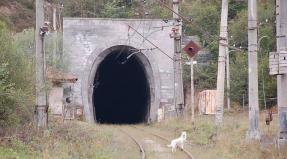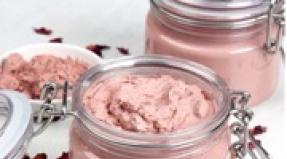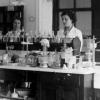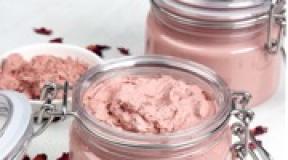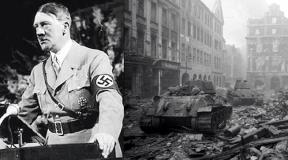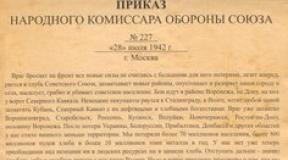Calculation of the heat of combustion of a mixture of gases. Calculation of heat of combustion. Calculation of mass calorific value
The heat of combustion, or calorific value (calorific value), of fuel Q is the amount of heat released during complete combustion of 1 mole (kcal/mol), 1 kg (kcal/kg) or 1 m3 of fuel (kcal/m3),
The volumetric calorific value is usually used in calculations involving the use of gaseous fuel. In this case, the heat of combustion of 1 m3 of gas is distinguished under normal conditions, i.e. at a gas temperature of 0 ° C and a pressure of 1 kgf/cm2, and under standard conditions - at a temperature of 20 ° C and a pressure of 760 mm Hg. Art.:
Vct - 293 "norm -
In this book, calculations of the heat of combustion of gaseous fuel are given for 1 m3 under normal conditions.
For normal conditions, the volumes of combustion products of all types of fuel were also calculated.
When analyzing fuel and in thermal calculations, one has to deal with higher and lower calorific values.
The higher calorific value of fuel QB, as already mentioned, is the amount of heat released during complete combustion of a unit of fuel with the formation of CO2, liquid HgO and SO2. Close to the highest calorific value is the calorific value determined when fuel is burned in a calorimetric bomb in an oxygen atmosphere<2б. Незначительное отличие теплоты сгорания в бомбе от высшей теплоты сгорания QB обусловлено тем, что при сжигании в атмосфере кислорода топливо окисляется более глубоко, чем при его сгорании на воздухе. Так, например, сера топлива сгорает в калориметрической бомбе не до SO2, а до S03, и при сжигании топлива в бомбе образуются серная и азотная кислоты.
The lower calorific value of fuel QH, as mentioned above, is the amount of heat released during complete combustion of a unit of fuel with the formation of CO2, HgO in the vapor state and SO2. In addition, when calculating the lower calorific value, the heat consumption for evaporation of fuel moisture is taken into account.
Consequently, the lower heat of combustion differs from the higher heat consumption for the evaporation of moisture contained in the fuel Wр and
Produced during the combustion of hydrogen contained in the fuel
When calculating the difference between the higher and lower calorific values, the heat consumption for the condensation of water vapor and for cooling the resulting condensate to 0 °C is taken into account. This difference is about 600 kcal per 1 kg of moisture, i.e. 6 kcal for every percent of moisture contained in the fuel or formed during the combustion of hydrogen included in the fuel mixture.
The values of the higher and lower calorific values of various types of fuel are given in table. 18.
For fuels with low hydrogen and moisture content, the difference between the higher and lower heating values is small, for example, for anthracite and coke - only about 2%. However, for fuels with high hydrogen and moisture content, this difference becomes quite significant. Thus, for natural gas, consisting mainly of CH4 and containing 25% (according to imaos) H, the higher calorific value exceeds the lower one by 11%.
The higher calorific value of the combustible mass of firewood, peat and brown coal, containing about 6% H, exceeds the lower calorific value by 4-5%. The difference between the higher and lower calorific values of the working mass of these very wet fuels is much greater. It is about 20%.
When assessing the efficiency of using these types of fuel, it is essential what calorific value is taken into account - higher or lower.
In the USSR and in most foreign countries, thermal engineering calculations are usually performed on the basis of the lower calorific value of fuel, since the temperature of the flue gases removed from fuel-using installations exceeds 100 °C, and, therefore, condensation of water vapor contained in the combustion products does not occur .
In the UK and USA, similar calculations are usually performed on the basis of the gross calorific value of the fuel. Therefore, when comparing data from tests of boilers and furnaces performed on the basis of lower and higher calorific values, it is necessary to make an appropriate recalculation of Qн and QB using the formula
Q„=QB-6(G + 9H) kcal/kg. (II.2)
In thermotechnical calculations, it is advisable to use both values of the calorific value. Thus, to assess the efficiency of using natural gas in boiler houses equipped with contact economizers, at a flue gas temperature of about 30-40 ° C, the highest calorific value should be taken, and the calculation in conditions where condensation of water vapor does not occur is more convenient to perform based on the lower calorific value combustion.
The heat of combustion of the fuel is determined by the composition of the combustible mass and the ballast content in the working mass of the fuel.
The heat of combustion of combustible fuel elements varies significantly (hydrogen has about 4 times more than carbon, and 10 times more than sulfur).
The heat of combustion of 1 kg of gasoline, kerosene, fuel oil, i.e. liquid fuel with a high hydrogen content, significantly exceeds the heat of combustion of the combustible mass of coke, anthracite and other types of solid fuel with a high carbon content and a very low hydrogen content. The heat of combustion of a combustible mass of fuel is determined by its elemental composition and the chemical composition of its constituent compounds.
The highest heat of combustion of atomic hydrogen generated in special installations is about 85,500 kcal/kg-atom, and the highest
|
The value of the higher and lower heating values of some types of fuel
|
The heat of combustion of molecular hydrogen contained in gaseous fuel is only 68,000 kcal/mol. The difference in the heat of combustion (2-85,500-68,000), amounting to about 103,000 kcal/mol, is due to the energy consumption to break the bonds between hydrogen atoms.
Naturally, the difference in the amount of heat released during the combustion of hydrogen, which is part of the combustible mass of various types of fuel, is incomparably less than the difference between the heats of combustion of atomic and molecular hydrogen, but it still occurs.
The nature of the bonds between the carbon atoms in the molecule also has a significant impact on the heat of combustion of the fuel.
The composition of various types of fuel includes hydrocarbons of various homologous series. The influence of the nature of chemical bonds between atoms on the heat of combustion of the combustible mass of fuel is evident from consideration of the composition and heat of combustion of hydrocarbon fuel.
1. Alkanes (paraffin hydrocarbons) are saturated hydrocarbons of aliphatic structure. The general formula of alkanes is SpNgn+2, or CH3- (CHg) p-2-CH3.
The lightest hydrocarbon, methane CH4, is included in. the composition of the majority of technical gases and is the main component of natural gases: Stavropol, Shebelinsky, Tyumen, Orenburg, etc. Ethane СгНв is found in oil and natural gases, as well as in gases obtained by dry distillation of solid fuels. Liquefied gases mainly consist of propane C3H8 and butane C4H10.
Alkanes with high molecular weight are found in various types of liquid fuels. In the molecules of saturated hydrocarbons there are the following bonds between atoms: C-H and C-C. For example, the structural formula of normal hexane C6Hi4 is
I I I I I I n n n n n n
There are 5 C-C bonds and 14 C-H bonds in a hexane molecule.
2. Cyclans are saturated hydrocarbons of cyclic structure. The general formula of cyclans is SpN2p.
|
6 C-C bonds and 12 C-H bonds. 3. Alkenes are unsaturated monoolefin hydrocarbons. General formula SpNgp. The lightest hydrocarbon of this homologous series, ethylene (ethene), is found in coke and semi-coke gases; it is included in significant quantities in oil refinery gases. Bonds between atoms: C-H, C-C and one double (olefinic) bond between two carbon atoms C = C; for example, in normal hexene C6H12 (hexene-1) 5. Alkynes - unsaturated hydrocarbons of aliphatic structure with a triple bond C = C. The general formula of alkynes is SpN2p-2. The most important of the hydrocarbons of this class is acetylene HC = CH. Bonds between atoms in alkynes: H-C, C-C and C=C. The heat of combustion and heat performance of hydrocarbons is strongly influenced by the energy of breaking bonds between atoms in a molecule. Warm? and the breaking of the H-H bond with the formation of atomic hydrogen is about 103 thousand kcal/mol. In table 19 shows data on the heats of bond cleavage in hydrocarbons according to Ya. K. Syrkin and M. E. Dyatkina G161 and according to L. Paulin - GU. Table 19 |
To find out the influence of the nature of bonds between carbon atoms in a hydrocarbon molecule on the heat of their combustion, it is advisable to use not the absolute values of the energy of bonds between atoms, but the differences in the energy reserve due to the different nature of the bonds: between atoms in the molecule.
When comparing the heats of breaking bonds between carbon atoms in a hydrocarbon molecule, it is easy to see that breaking one double bond requires significantly less energy than breaking two single bonds. The energy consumption for breaking one triple bond is even less than the energy consumption for breaking three single bonds. To establish the effect of differences in the heats of cleavage of double and single bonds between carbon atoms on the heat of combustion
29-
hydrocarbons, let’s compare two hydrocarbons of different structures: ethylene H2C=CH2 and cyclohexane CeHi2. Both hydrocarbons have two hydrogen atoms per carbon atom. However, the unsaturated hydrocarbon ethylene has a double bond between its carbon atoms, while the saturated cyclic hydrocarbon cyclohexane has single bonds between its carbon atoms.
For ease of calculation, we compare three moles of ethylene (3-C2H4) with one mole of cyclohexane (CeHi2), since in this case, when the bonds between atoms are broken, the same number of gram atoms of carbon and hydrogen is formed.
The energy required to break bonds between atoms in three moles of ethylene C2H4 is less than the energy required to break bonds in one mole of cyclohexane SwH12. In fact, in both cases it is necessary to break 12 C-H bonds between the carbon and hydrogen atoms, and in addition to this, in the first case, three double C = C bonds, and in the second case, six single C-C bonds, which entails a large energy consumption.
Since the number of gram atoms of carbon and hydrogen obtained by breaking bonds in three moles of ethylene and one mole of cyclohexane is the same, the heat of combustion of three moles of ethylene should be higher than the heat of combustion of one mole of cyclohexane by the number of kilocalories corresponding to the difference in the heats of breaking bonds between atoms in one mole of cyclohexane and three moles of ethylene.
The lowest heat of combustion of three moles of ethylene is 316-3 = 948 thousand kcal, and one mole of cyclohexane is 882 thousand kcal.
The heat of formation of hydrocarbons from graphite and molecular hydrogen can be calculated using the formula
Where Qc„Hm is the lower heat of combustion of the hydrocarbon, kcal/mol; Qc is the heat of combustion of carbon in the form of graphite, kcal/kg-atom; n is the number of carbon atoms in a hydrocarbon molecule; Qh2 - lower heat of combustion of molecular hydrogen, kcal/mol; t is the number of hydrogen atoms in a hydrocarbon molecule.
In table 20 shows the heats of formation of graphite and molecular hydrogen gas from some hydrocarbons and shows the ratios of the heats of formation to the heats of combustion of the corresponding amounts of carbon and molecular hydrogen.
Let us consider several examples illustrating the validity of the above provisions.
Methane CH4. The lowest calorific value is 191.8 thousand kcal/mol. The heat content of 1 kg carbon atom and 2 kmol of hydrogen, equivalent to 1 kmol of methane, is equal to 94 + 2-57.8 = 209.6 thousand kcal. Hence, the heat of formation of graphite and molecular hydrogen from methane is 191.8-209.6 = -17.8 thousand kcal/mol.
The ratio of the heat of formation of carbon and hydrogen from methane to the sum of the heat of combustion of carbon and hydrogen formed from methane is equal to
|
Table 20 Heat of combustion of hydrocarbons and equivalent amounts of carbon and hydrogen
|
The ratio of the heat of formation of carbon and hydrogen from ethane to the sum of the heat of combustion formed from ethane, carbon and hydrogen is 20-100
AC>=-ZbM~ = -5’5%-
Propane SzN8. The lowest heat of combustion of propane is 488.7 thousand kcal/mol. The sum of the heats of combustion of carbon and hydrogen equivalent to propane is equal to
3-94+4-57.8=513.2 thousand kcal/mol.
Heat of formation of graphite and hydrogen from propane
488.7-513.2=-24.5 thousand kcal/mol.
The ratio of the heat of formation of carbon and hydrogen from propane to the sum of the heats of combustion of the resulting carbon and hydrogen is equal to -24.5-100
L<2=——— 513^- =-4,8%.
Ethylene (ethene) CaH4. The lower heat of combustion of ethylene is 316.3 thousand kcal/mol. The sum of the heat of combustion equivalent to one mole of ethylene, 2 kg-atom of carbon and 2 kmol of hydrogen is equal to 303.6 thousand kcal/mol.
The heat of formation of graphite and hydrogen from ethylene is equal to
316.3-303.6 = 12.7 thousand kcal/mol.
Consequently, the ratio of the heat of formation of carbon and hydrogen from ethylene to the sum of the heat of combustion formed from carbon and hydrogen by ethylene is 12.7-100
A
Propylene (propene) C3Hb. The lower heat of combustion of propylene is 460.6 thousand kcal/mol. The sum of the heat of combustion equivalent to 1 mole of propylene, 3 kg carbon atom and 3 kmol of hydrogen is equal to 455.4 thousand kcal/mol.
The heat of formation of graphite and hydrogen from propylene is
460.6-455.4 = 5.2 thousand kcal/mol,
The ratio of the heat of formation of carbon and hydrogen from propylene to the sum of their heats of combustion is equal to
The heat of decomposition into carbon and molecular hydrogen in the first members of the corresponding homologous series of unsaturated hydrocarbons is positive (the reaction is exothermic), and with an increase in molecular weight, the heat of decomposition decreases and becomes a negative value. Consequently, among the unsaturated hydrocarbons there must be a substance of a certain molecular weight, the heat of decomposition of which into carbon and hydrogen is small.
In the series of unsaturated hydrocarbons with one double bond - alke - butylene is such a new carbon
CH2 =CH-CH2-CHN.
The heat of decomposition of 1 kmol of butylene into carbon and molecular hydrogen is only ~600 kcal, which is about 0.1% of the sum of the heats of combustion generated during the decomposition of butylene into carbon and hydrogen.
In accordance with the above, the heat of combustion of hydrocarbons and other organic substances is more accurately determined by their group component composition. However, it is practically possible to determine the heat of combustion of a fuel based on its group component composition only for gaseous fuel.
Determining the group composition of liquid and especially solid fuel is so difficult that one has to confine oneself to determining only the elementary composition of the fuel and calculating the heat of combustion according to the data of an elementary analysis of the combustible mass of the fuel and the content of ballast in the working mass of the fuel. In addition to carbon, hydrogen and sulfur, the combustible mass of fuel includes nitrogen and oxygen.
Each percent of nitrogen contained in the combustible mass of fuel reduces its heat of combustion by 1%. The nitrogen content in the combustible mass of liquid fuel is usually tenths of a percent, in solid fuel 1-2%. Therefore, the presence of nitrogen in the flammable mass of liquid and... solid fuel has relatively little effect on its calorific value.
In gaseous fuel, unlike liquid and solid, nitrogen is not part of the components of the combustible mass, but is contained in the form of molecular nitrogen N2 and is a ballasting component. The nitrogen content of some types of gaseous fuel is very high and greatly affects its calorific value.
|
Dependence of the heat of combustion and heat output of the combustible mass of solid fuel on the oxygen content in it1
|
As mentioned above, each percent of chemically bound oxygen contained in a combustible mass reduces its heat of combustion by 26 kcal/kg.
Thus, a 1% increase in the oxygen content in the combustible mass of solid fuel, for example, coal with a calorific value of about 8000 kcal/kg, reduces the heat of combustion of the combustible mass of fuel by 1% as a result of a decrease in the carbon and hydrogen content and by (26-100) -.8000=0.32% due to partial oxidation of the combustible mass of fuel, and only about 1.3%. Consequently, a change in the oxygen content in the combustible mass of the fuel greatly affects its heat of combustion.
The heats of combustion of a combustible mass of solid fuel containing about 6% hydrogen, a relatively low sulfur content and various oxygen and carbon contents are given in Table. 21.
The data given in the table show that the heat of combustion of the combustible mass of fatty coal is 80% higher than the heat of combustion of the combustible mass of wood due to the lower oxygen content and, accordingly, the higher carbon content.
Ballast in fuel sharply reduces its heat of combustion, primarily due to a corresponding decrease in the content of combustible mass. In addition, part of the heat is spent on the evaporation of moisture, and if the fuel contains a significant mineral mass, also on its decomposition at high temperatures in the furnaces. Accordingly, the proportion of useful heat is reduced.
In hard coals with a calorific value of about 6000 kcal/kg, an increase in moisture content by 1% reduces the lower calorific value by 66 kcal/kg, including by 60 kcal/kg as a result of an increase in the ballast content in the fuel and by 6 kcal/kg due to consumption heat to evaporate moisture.
2 B M Rarich 33
Thus, the additional heat consumption for the evaporation of moisture is only Vio from the decrease in the calorific value due to the decrease in the content of combustible mass in the fuel. For fuel oil with a calorific value of more than 9000 kcal/kg, the share of additional heat consumption for moisture evaporation is even less (Table 22).
Table 22
|
Change in the lower heating value of fuel with an increase in moisture content by 1%
|
For fuel with a constant composition of the combustible mass and low ash content, the calorific value of combustion is clearly determined by the moisture content. Therefore, for such types of fuel as firewood, the lower calorific value of the working mass QS can be determined depending on the moisture content using the formula
Qjj (100 - WV) - 600WP
QЈ=—————— jqq————— kcal/kg,
Where QЈ is the lower calorific value of dry fuel (a slightly varying value, taken from reference tables), kcal/kg; - moisture content, determined by analyzing the working fuel, % by mass).
With variable ash content of the fuel, the lower heat of combustion of the working mass is calculated from the heat of combustion of the combustible mass using the formula
600WP
Qk=———————- jqq—————— kcal/kg,
Where Qh is the lower heat of combustion of the combustible mass, kcal/kg; Lr - fuel ash content, %’. - fuel humidity, %
Thermal effect reaction is the amount of heat that is released or absorbed by the system during the reaction.
where , are the stoichiometric coefficients of the reaction products and starting materials; , - standard enthalpies of formation of reaction products and starting materials. Heat of formation. Here the index means formation(formation), and zero, that the value refers to the standard state of matter.
Heat of formation substances is determined from reference books or calculated based on the structure of the substance.
Heat of combustion is the amount of heat released during the complete combustion of a unit amount of a substance, provided that the initial and final products are under standard conditions.
There are:
· molar- for one mole (kJ/mol),
· massive− for one kilogram (kJ/kg),
· volumetric− for one cubic meter of substance (kJ/m³) heat of combustion.
Depending on the state of aggregation of the water formed during the combustion process, higher and lower calorific values are distinguished.
Higher calorific value is the amount of heat that is released during the complete combustion of a unit amount of a combustible substance, including the heat of condensation of water vapor.
Lower calorific value is the amount of heat that is released during the complete combustion of a unit amount of a combustible substance, provided that the water in the combustion products is in a gaseous state.
The molar heat of combustion is calculated in accordance with the law Hess. To convert the molar heat of combustion into mass heat, you can use the formula:
where is the molar mass of the flammable substance, .
For substances in the gaseous state, when converting from standard heat of combustion to volumetric heat, use the formula:
where is the molar volume of the gas, which under standard conditions is equal to .
Sufficiently accurate results for complex combustible substances or mixtures are given by the Mendeleev formula for higher calorific value:
Where , ; , , , , - the content of carbon, hydrogen, sulfur, oxygen and nitrogen in the combustible substance, respectively, in mass. percent.
For lower calorific value
Where , ; - moisture content in the flammable substance in mass. percent.
Calculation of the heat of combustion of combustible mixtures is carried out according to the formula
where is the lower heat of combustion of the combustible mixture, ; - volume fraction of fuel in the mixture; - lower calorific value of the th fuel in the mixture, .
Calculation of the heat of combustion of gas-air mixtures is carried out using the formula
where is the lower heat of combustion of a combustible substance, ; - concentration of flammable substance in the gas-air mixture, volume fraction; - heat of combustion of the gas-air mixture, .
Heat capacity body is a physical quantity that determines the ratio of an infinitesimal amount of heat received by the body to the corresponding increment in its temperature
The amount of heat supplied to or removed from a body is always proportional to the amount of substance.
Specific heat capacity is called the heat capacity per unit amount of a substance. The amount of a substance can be measured in kilograms, cubic meters and moles. Therefore, a distinction is made between mass, volumetric and molar heat capacity.
Let's denote:
· - molar heat capacity, . This is the amount of heat that needs to be suspended in 1 mole of a substance so that its temperature increases by 1 Kelvin;
· - mass heat capacity, . This is the amount of heat that needs to be suspended in 1 kilogram of a substance so that its temperature increases by 1 Kelvin;
· - volumetric heat capacity, . This is the amount of heat that needs to be suspended in 1 cubic meter of a substance so that its temperature increases by 1 Kelvin.
The relationship between molar and mass heat capacities is expressed by the formula
where is the molar mass of the substance. Volumetric heat capacity is expressed in terms of molar heat capacity as follows
where is the molar volume of gas under normal conditions.
The heat capacity of a body depends on the process during which heat is supplied.
Heat capacity of a body at constant pressure is the ratio of the specific (per 1 mole of substance) amount of heat supplied in an isobaric process to the change in body temperature.
Heat capacity of a body at constant volume is the ratio of the specific (per 1 mole of substance) amount of heat supplied in an isochoric process to the change in body temperature.
The heat capacity of ideal gases is
where is the number of degrees of freedom of the molecule. The relationship between the isobaric and isochoric heat capacities of ideal gases is determined by the Mayer equation
where is the universal gas constant.
The heat capacity of substances in the solid phase for conditions close to normal according to the Dulong-Petit law is equal to
Due to the fact that heat capacity depends on temperature, heat consumption for the same increase in temperature changes (Fig. 3.1).
True heat capacity is called the heat capacity, which, under a certain thermodynamic process, is expressed by the following formula
where - denotes the process in which the heat capacity is measured. The parameter can take values , etc.
Rice. 3.1. Dependence of heat capacity on temperature
Average heat capacity is the ratio of the amount of heat imparted to a body in a given process to the change in temperature, provided that the temperature difference is a finite value. Given the known dependence of the true heat capacity on temperature, the average heat capacity over the temperature interval from to can be found using the mean value theorem
where is the average heat capacity, is the true heat capacity.
In experimental studies of the heat capacity of substances, the average heat capacity is often found as a function of the upper limit, with a fixed value of the lower limit, which is taken equal to
The dependences of the average heat capacities of gases on the upper limit temperature are given in Table 3.1.
The heat capacity of a gas mixture depends on the composition of the mixture and the heat capacities of the components. Let us denote: - the mole fraction of the component in the mixture; - volume fraction; - mass fraction. Here is the amount of the th component in moles, m 3, kg, respectively. The heat capacity of a gas mixture can be determined by the formulas
where , , are the average molar, mass and volumetric heat capacities of the th mixture component.
Table 3.1.
| Gas name | Formulas for determining the average molar heat capacities of individual gases at constant volume, J/(mol deg), for temperatures, 0 C | |
| from 0 to 1500 | from 1501 to 2800 | |
| Air | ||
| Oxygen | ||
| Nitrogen | ||
| Hydrogen | ||
| Carbon monoxide | ||
| Carbon dioxide | ||
| water vapor |
In heat engines and engines, at the beginning of each cycle, a portion of fresh mixture is supplied to the combustion chamber, which is called fresh charge. However, as a rule, exhaust gases from the previous cycle remain in the combustion chamber.
Residual gas coefficient called relation
where is the number of moles of residual gases, is the number of moles of fresh charge. The mixture of residual gases with a fresh charge in the combustion chamber is called working mixture. The heat capacity of the working mixture is calculated by the formula
where , are the average heat capacities of the fresh charge and residual gases at the temperature of the working mixture; - coefficient of residual gases.
The heat released in the combustion zone is spent on heating combustion products and heat loss (the latter include preheating of the combustible substance and radiation from the combustion zone into the environment). The maximum temperature to which combustion products are heated is called combustion temperature.
Depending on the conditions under which the combustion process occurs, there are calorimetric, adiabatic, theoretical, And valid combustion temperature.
Under calorimetric combustion temperature understand the temperature to which combustion products are heated under the following conditions:
· all the heat released during the reaction goes to heating the combustion products;
· complete combustion of the stoichiometric combustible mixture occurs ();
· in the process of formation of combustion products, their dissociation does not occur;
· the combustible mixture is at an initial temperature of 273 K and a pressure of 101.3 kPa.
Adiabatic combustion temperature is determined for a non-stoichiometric combustible mixture ().
Theoretical combustion temperature differs from the calorimetric one in that the calculations take into account heat losses due to the dissociation of combustion products.
Actual combustion temperature- this is the temperature to which combustion products are heated in real conditions.
Let us consider the calculation of only the calorimetric and adiabatic combustion temperatures with a slight correction. We will assume that the initial temperature of the initial mixture differs from . Let us denote the number of moles of the working mixture and the mixture of combustion products. Then the heat balance of combustion at constant pressure can be written as follows:
where , are the average heat capacities of the initial mixture and combustion products; - heat released during the combustion of 1 mole of the working mixture; and - temperatures of the working mixture and combustion products, respectively. In relation to one mole of the working mixture, formula (3.20) can be represented as
where is the coefficient of molecular change in the composition of the mixture. The calorimetric and adiabatic combustion temperatures are found from the heat balance equation.
The pressure during an explosion can be found using the Clayperon-Mendeleev equation, taking into account that the volume does not change during the process.
Practical work No. 3
“Calculation of the heat of combustion of substances”
Target: Understand the basic concepts of the energy balance of combustion processes. Learn to calculate the heat of combustion for different types of combustible substances (individual substances and mixtures; complex substances represented by elementary composition).
Calculation formulas and algorithms
1. To calculate the calorific value individual substances formula (3.1) is used. First, an equation for the combustion reaction is compiled, with the help of which the stoichiometric coefficients and products are determined. Then, using the table (see Table 3.1), the standard enthalpies of formation of the starting substances and reaction products are found. The found parameters are substituted into formula (3.1) and the heat of combustion of the combustible substance is calculated.
2. Heat of combustion complex substances found using D.I. Mendeleev’s formulas (3.4) and (3.5). To perform the calculation, you only need to know the mass fractions of elements in percent. The heat of combustion is calculated in kJ/kg.
3. For calculation flammable mixtures use formulas (3.1) – (3.6). First, find the lower heat of combustion of each combustible gas as an individual substance using formula (3.2) or as a complex substance using formulas (3.4), (3.5). To go to the volumetric heat of combustion, formulas (3.2), (3.3) are used. The calculation is completed by calculating the lower calorific value of the combustible mixture using formula (3.6).
4. To determine the heat of combustion of 1 m 3 gas-air mixture calculate the volume fraction of combustible gases in the presence of air, the amount of which depends on. Then, using formula (3.7), the heat of combustion of the gas-air mixture is calculated.
Example 3.1. Determine the lower calorific value of acetylene.
Solution. Let us write the equation for the combustion of acetylene.
In accordance with the equation, the stoichiometric coefficients are , , , . Using Appendix 3.1 we find the standard enthalpies of formation of reaction substances: , , , . Using formula (3.1) we calculate the lower calorific value of acetylene
To calculate the amount of heat released during the combustion of 1 m3 of acetylene, it is necessary to divide the resulting value by the molar volume under standard conditions (3.3):
Answer: ;
Solution. Using Mendeleev’s formulas (3.4) and (3.5) we find
Answer: .
Example 3.3. Determine the heat of combustion of a gas mixture consisting of - 40%, - 20%, - 15%, - 5%, - 10%, - 10%.
Solution. Of these gases, , , , are flammable. Let us write out the reaction equation with oxygen for each fuel:
We find the standard enthalpies of formation of substances using tabular data in Table 3.2.
; ; ; ; ; ; ; .
Using formula (3.1) in accordance with combustion equations (1)-(4), we find the heat of combustion, :
For a mixture of flammable gases, we use formula (3.6), taking into account that the molar and volume fractions are the same. As a result of calculations, we obtain the lowest heat of combustion of a mixture of gases
When 1 m 3 of such a mixture of gases is burned, heat is released equal to
Answer: ; .
Solution. We write the propane combustion equation
According to the reaction equation, per 1 m 3 of propane there should be m 3 of air for a stoichiometric mixture. Considering that 1 m 3 of propane actually consumes m 3 of air. Thus, in 1 m3 in a propane-air mixture, the volume fraction of propane will be
We find the lower calorific value of propane using formula (3.1). The standard enthalpy of formation of propane can be determined from Table 3.2.
The calorific value of propane is
The lower calorific value of a propane-air mixture can be determined by formula (3.7)
1536,21
Table 3.3. Parameters for test task No. 3.1
| Option | Condition | Option | Condition | Option | Condition |
| 1. | CH3OH | 11. | C4H8 | 21. | C 8 H 18 |
| 2. | C2H5OH | 12. | C4H10 | 22. | C 10 H 8 |
| 3. | NH 3 | 13. | C 3 H 8 | 23. | C 12 H 10 |
| 4. | SO 3 | 14. | C 7 H 8 | 24. | CH4O |
| 5. | HNO3 | 15. | C 7 H 16 | 25. | C2H4O2 |
| 6. | C3H4 | 16. | C5H12 | 26. | C2H6O |
| 7. | H2S | 17. | C6H12 | 27. | C3H6O |
| 8. | C5H5N | 18. | C6H14 | 28. | C4H10O |
| 9. | C 2 H 5 O | 19. | C8H6 | 29. | CH6N2 |
| 10. | C3H6 | 20. | C 8 H 10 | 30. | C6H7N |
Table 3.4. Parameters for test task No. 3.2 ( W - moisture)
Higher calorific value(superior calorific value): The amount of heat that can be released upon complete combustion of a certain amount of gas in air in such a way that the pressure p 1 at which the reaction occurs remains constant and all combustion products take on the same temperature t 1, the same as the temperature of the reagents. In this case, all products are in a gaseous state, with the exception of water, which condenses into liquid when t 1 .
Net calorific value(inferior calorific value): The amount of heat that can be released upon complete combustion of a certain amount of gas in air such that the pressure p 1 at which the reaction occurs remains constant, all combustion products take on the same temperature t 1 as the temperature of the reactants. In this case, all products are in a gaseous state.
The value of the molar heat of combustion of an ideal gas, determined based on the values of the molar fraction of the components of a mixture of known composition, at temperature t 1 is calculated using formula (5):
where is the value of the ideal heat of combustion of the mixture (higher or lower);
– molar fraction of the jth component;
– the value of the ideal heat of combustion of the j-th component (highest or lowest).
Numerical values for t 1 =25 °C are given in GOST 31369-2008 (Table 3 of Section 10).
4.2.2 Calculation of mass calorific value
The value of the mass heat of combustion of an ideal gas, determined based on the values of the mass fraction of components of a mixture of known composition, at temperature is calculated using formula (6):
where is the mole fraction j-th component;
-molar mass j th component.
4.2.3 Calculation of volumetric calorific value
The value of the heat of combustion of an ideal gas, calculated on the basis of the values of the volume fraction of the components, for the combustion temperature t 1 mixture of known composition, measured at temperature t 2 and pressure p 1, calculated by formula (8):
|
|
where is the value of the ideal (highest or lowest) volumetric heat of combustion of the mixture;
R– universal gas constant;
T 2 – absolute temperature, K.
4.2.4 Calculation of density, relative density and Wobbe number
Density(density): The mass of a gas sample divided by its volume at specified pressures and temperatures.
Relative density(relative density): Gas density divided by the density of dry air of standard composition (Appendix B GOST 31369-2008) at the same specified pressure and temperature values. The term “ideal relative density” is used in cases where both gas and air are considered to be media that obey the ideal gas law; the term “real relative density” is used in cases where both gas and air are considered real media.
Wobbe number(Wobbe index): The value of the gross volumetric heating value at specified standard conditions, divided by the square root of the relative density at the same standard measurement conditions.
The Wobbe number is a characteristic of a combustible gas that determines the interchangeability of combustible gases when burned in domestic and industrial burners, measured in megajoules per cubic meter.
Relative density ideal gas does not depend on the choice of the standard state, and it is calculated using formula (9):
where is the relative density of an ideal gas;
– molar mass of the jth component;
5. THERMAL BALANCE OF COMBUSTION
Let's consider methods for calculating the heat balance of the combustion process of gaseous, liquid and solid fuels. The calculation comes down to solving the following problems.
· Determination of the heat of combustion (calorific value) of fuel.
· Determination of theoretical combustion temperature.
5.1. HEAT OF COMBUSTION
Chemical reactions are accompanied by the release or absorption of heat. When heat is released, the reaction is called exothermic, and when heat is absorbed, it is called endothermic. All combustion reactions are exothermic, and combustion products are exothermic compounds.
The heat released (or absorbed) during a chemical reaction is called the heat of reaction. In exothermic reactions it is positive, in endothermic reactions it is negative. The combustion reaction is always accompanied by the release of heat. Heat of combustion Q g(J/mol) is the amount of heat that is released during the complete combustion of one mole of a substance and the transformation of a combustible substance into products of complete combustion. The mole is the basic SI unit of quantity of a substance. One mole is the amount of substance that contains the same number of particles (atoms, molecules, etc.) as there are atoms in 12 g of the carbon-12 isotope. The mass of an amount of a substance equal to 1 mole (molecular or molar mass) numerically coincides with the relative molecular mass of this substance.
For example, the relative molecular weight of oxygen (O 2) is 32, carbon dioxide (CO 2) is 44, and the corresponding molecular weights will be M = 32 g/mol and M = 44 g/mol. Thus, one mole of oxygen contains 32 grams of this substance, and one mole of CO 2 contains 44 grams of carbon dioxide.
In technical calculations, it is not the heat of combustion that is most often used. Q g, and the calorific value of the fuel Q(J/kg or J/m 3). The calorific value of a substance is the amount of heat released during complete combustion of 1 kg or 1 m 3 of a substance. For liquid and solid substances, the calculation is carried out per 1 kg, and for gaseous substances - per 1 m 3.
Knowledge of the heat of combustion and calorific value of the fuel is necessary to calculate the combustion or explosion temperature, explosion pressure, flame propagation speed and other characteristics. The calorific value of the fuel is determined either experimentally or by calculation. When experimentally determining the calorific value, a given mass of solid or liquid fuel is burned in a calorimetric bomb, and in the case of gaseous fuel, in a gas calorimeter. These instruments measure the total heat Q 0 released during combustion of a sample of fuel weighing m. Calorific value Q g is found by the formula
The relationship between the heat of combustion and
calorific value of fuel
To establish a connection between the heat of combustion and the calorific value of a substance, it is necessary to write down the equation for the chemical reaction of combustion.
The product of complete combustion of carbon is carbon dioxide:
C+O2 →CO2.
The product of complete combustion of hydrogen is water:
2H 2 +O 2 →2H 2 O.
The product of complete combustion of sulfur is sulfur dioxide:
S +O 2 →SO 2.
In this case, nitrogen, halogens and other non-combustible elements are released in free form.
Combustible substance - gas
As an example, let us calculate the calorific value of methane CH 4, for which the heat of combustion is equal to Q g=882.6 .
· Let's determine the molecular weight of methane in accordance with its chemical formula (CH 4):
M=1∙12+4∙1=16 g/mol.
· Let's determine the calorific value of 1 kg of methane:
· Let's find the volume of 1 kg of methane, knowing its density ρ=0.717 kg/m3 under normal conditions:
 .
.
· Let's determine the calorific value of 1 m 3 of methane:
The calorific value of any combustible gases is determined similarly. For many common substances, heat of combustion and calorific values have been measured with high accuracy and are given in the relevant reference literature. Here is a table of the calorific values of some gaseous substances (Table 5.1). Magnitude Q in this table is given in MJ/m 3 and in kcal/m 3, since 1 kcal = 4.1868 kJ is often used as a unit of heat.
Table 5.1
Calorific value of gaseous fuels
|
Substance |
Acetylene |
|||||
|
Q |
||||||
Combustible substance - liquid or solid
As an example, let us calculate the calorific value of ethyl alcohol C 2 H 5 OH, for which the heat of combustion is Q g= 1373.3 kJ/mol.
· Let's determine the molecular weight of ethyl alcohol in accordance with its chemical formula (C 2 H 5 OH):
M = 2∙12 + 5∙1 + 1∙16 + 1∙1 = 46 g/mol.
Let's determine the calorific value of 1 kg of ethyl alcohol:
The calorific value of any liquid and solid combustibles is determined similarly. In table 5.2 and 5.3 show the calorific values Q(MJ/kg and kcal/kg) for some liquids and solids.
Table 5.2
Calorific value of liquid fuels
|
Substance |
Methyl alcohol |
Ethanol |
Fuel oil, oil |
||||
|
Q |
|||||||
Table 5.3
Calorific value of solid fuels
|
Substance |
The tree is fresh |
Dry wood |
Brown coal |
Dry peat |
Anthracite, coke |
||
|
Q |
|||||||
Mendeleev's formula
If the calorific value of the fuel is unknown, then it can be calculated using the empirical formula proposed by D.I. Mendeleev. To do this, you need to know the elemental composition of the fuel (equivalent fuel formula), that is, the percentage content of the following elements in it:
Oxygen (O);
Hydrogen (H);
Carbon (C);
Sulfur (S);
Ashes (A);
Water (W).
The products of fuel combustion always contain water vapor, which is formed both due to the presence of moisture in the fuel and during the combustion of hydrogen. Waste combustion products leave an industrial plant at a temperature above the dew point. Therefore, the heat that is released during the condensation of water vapor cannot be usefully used and should not be taken into account in thermal calculations.
The net calorific value is usually used for calculation Q n fuel, which takes into account heat losses with water vapor. For solid and liquid fuels the value Q n(MJ/kg) is approximately determined by the Mendeleev formula:
Q n=0.339+1.025+0.1085 – 0.1085 – 0.025, (5.1)
where the percentage (wt.%) content of the corresponding elements in the fuel composition is indicated in parentheses.
This formula takes into account the heat of exothermic combustion reactions of carbon, hydrogen and sulfur (with a plus sign). Oxygen included in the fuel partially replaces oxygen in the air, so the corresponding term in formula (5.1) is taken with a minus sign. When moisture evaporates, heat is consumed, so the corresponding term containing W is also taken with a minus sign.
A comparison of calculated and experimental data on the calorific value of different fuels (wood, peat, coal, oil) showed that calculation using the Mendeleev formula (5.1) gives an error not exceeding 10%.
Net calorific value Q n(MJ/m3) of dry combustible gases can be calculated with sufficient accuracy as the sum of the products of the calorific value of individual components and their percentage content in 1 m3 of gaseous fuel.
Q n= 0.108[Н 2 ] + 0.126[СО] + 0.358[СН 4 ] + 0.5[С 2 Н 2 ] + 0.234[Н 2 S ]…, (5.2)
where the percentage (volume %) content of the corresponding gases in the mixture is indicated in parentheses.
On average, the calorific value of natural gas is approximately 53.6 MJ/m 3 . In artificially produced combustible gases, the content of methane CH4 is insignificant. The main flammable components are hydrogen H2 and carbon monoxide CO. In coke oven gas, for example, the H2 content reaches (55 ÷ 60)%, and the lower calorific value of such gas reaches 17.6 MJ/m3. The generator gas contains CO ~ 30% and H 2 ~ 15%, while the lower calorific value of the generator gas is Q n= (5.2÷6.5) MJ/m3. The content of CO and H 2 in blast furnace gas is lower; magnitude Q n= (4.0÷4.2) MJ/m3.
Let's look at examples of calculating the calorific value of substances using the Mendeleev formula.
Let us determine the calorific value of coal, the elemental composition of which is given in table. 5.4.
Table 5.4
Elemental composition of coal
· Let's substitute those given in the table. 5.4 data in the Mendeleev formula (5.1) (nitrogen N and ash A are not included in this formula, since they are inert substances and do not participate in the combustion reaction):
Q n=0.339∙37.2+1.025∙2.6+0.1085∙0.6–0.1085∙12–0.025∙40=13.04 MJ/kg.
Let us determine the amount of firewood required to heat 50 liters of water from 10° C to 100° C, if 5% of the heat released during combustion is consumed for heating, and the heat capacity of water With=1 kcal/(kg∙deg) or 4.1868 kJ/(kg∙deg). The elemental composition of firewood is given in table. 5.5:
Table 5.5
Elemental composition of firewood
|
· Let's find the calorific value of firewood using the Mendeleev formula (5.1): Q n=0.339∙43+1.025∙7–0.1085∙41–0.025∙7= 17.12 MJ/kg. · Let's determine the amount of heat spent on heating water when burning 1 kg of firewood (taking into account the fact that 5% of the heat (a = 0.05) released during combustion is spent on heating it): Q 2 =a Q n=0.05·17.12=0.86 MJ/kg. · Let's determine the amount of firewood required to heat 50 liters of water from 10° C to 100° C:
Thus, about 22 kg of firewood is required to heat water. |
 kg.
kg.